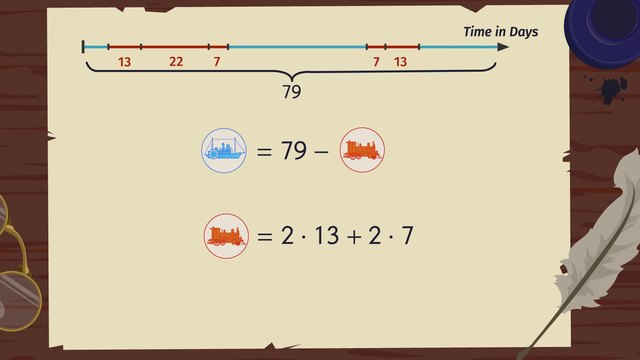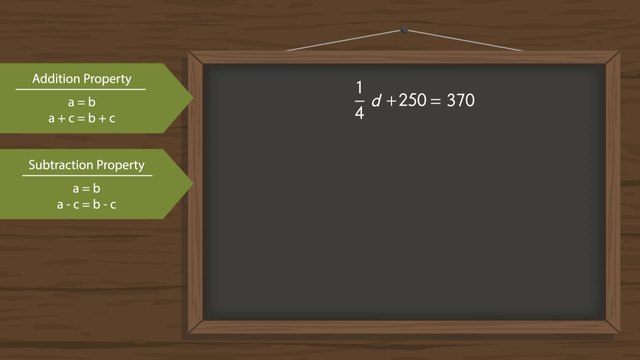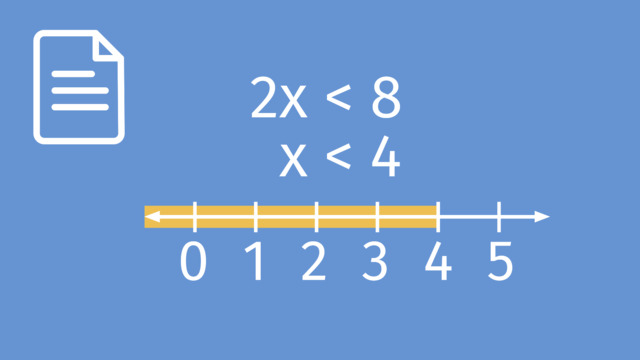Properties of Inequalities


Basics on the topic Properties of Inequalities
An inequality is a mathematical relation between two values. There are four different kinds of inequalities: two values can be less than each other, greater than each other, less than or equal to each other, or greater than or equal to each other. Understanding how to use these four inequalities and their properties opens up the possibility of expressing how two values relate to each other in a clear and concise manner. Learn about the different properties of inequalities by helping Jackson, a wildlife tracker, record observations about some interesting eating habits of crocodiles. Common Core Reference: CCSS.MATH.CONTENT.7.EE.B.4
Transcript Properties of Inequalities
Jackson's a wildlife tracker in Tanzania specializing in crocodiles. He's been tracking these creatures for a while and notices that when a croc has a choice of two antelopes for supper, the croc'll always go after the bigger one. Since the crocodile always wants the larger antelope, Jackson thinks the croc may understand inequalities and their properties. This is the simplified version of what Jackson sees: Jackson thinks the smaller antelope weighs about 90 lbs and the larger antelope, about 142 lbs. Mathematically, we can represent this with an inequality symbol because 90 is less than 142. Remember that inequality symbols always open towards the bigger number, just like the crocodile will open its mouth to the larger prey. It’s currently a plentiful season on the savanna, filled with lush vegetation. The antelopes have been getting plenty of food and have both put on 20 lbs. Simplified, we can see that 110 is less than 162. This is the Addition Property of Inequality. Here, we notice how we didn't change the inequality symbol, since we added the same amount to both sides of the equation. But, during the dry season, the antelopes lose 30 lbs. each. This is the Subtraction Property of Inequality. Here, we also see the the inequality remains true when we subtract the same amount from both sides. Oh no! It looks like the dry season has continued. The two antelopes lost an additional one eighth of their weight, which means they maintained seven eighths. Therefore, we can multiply both sides by seven eighths. This can also be written as 7 times 80 divided by 8 is less than 132 times 7 divided by 8. We can simplify our calculations on both sides first by dividing out the greatest common factors. The GCF of 80 and 8 is 8 and the GCF of 132 and 8 is 4. Now that we've reduced the fractions using their GCFs, the calculations look much easier! This inequality further simplifies to 70 is less than 115.5. This is called the Multiplication and Division Property of Positive Number Inequalities. Notice that the less than symbol remained the same when we multiplied both sides by 7 and divided both sides by 8. Let's look at this inequality on a number line. We know that 70 is less than 115.5. Furthermore, we know what happens when multiplying or dividing by positive numbers, but let’s take a look at what happens when we multiply both sides of an inequality by negative 1. This results in negative 70 is less than negative 115.5. Does that make sense? Looking at the number line, we can see that negative 70 is actually a larger number than negative 115.5. So, is there something we can do to make this statement true? We can change the inequality symbol. This is the Multiplication and Division Property of Negative Number Inequalities. Multiplying a number by negative number creates opposites. So, you have to remember to always flip the inequality symbol when multiplying by a negative number. We can double-check by reading the statement as a question. Is negative 70 greater than negative 115.5? Yup! We have a true mathematical sentence, ladies and gentlemen! Let's look at another problem. Say we have two numbers, negative 4 and positive 6. Looking at the relationship we can say that negative 4 is less than 6. What happens if we divide both sides by negative 2? The sign of each number changes and the numbers become half their original size. Negative 4 divided by negative 2 gives us 2, and 6 divided by negative 2 is negative 3. Since the signs of both numbers have changed, we have to flip the inequality symbol as well. This is the Division Property of Negative Number Inequalities. To check, let's read the statement as a question. Is 2 greater than negative 3? Yes it is. So we're right. Yippee! Wow! We've learned a lot, so let's look at this summary table to help review everything. When we add or subtract both sides of an inequality using the same number, we keep the original inequality symbol. When we multiply or divide both sides by a positive number we must also keep the inequality symbol. However, when we multiply or divide both sides of an inequality by a negative number, we have to flip the inequality symbol. Okay, getting back to Jackson. Hmm...it appears as though the crocodile is no longer interested in our thin antelopes. Hey...what’s that crocodile looking at?
Properties of Inequalities exercise
-
Describe the addition and subtraction properties of inequalities.
HintsLet's look at the following example:
Paul would like to buy some new headphones.
Type A headphones cost $20$ dollars, and type B headphones cost $25$ dollars.
First, we consider $20<25$.
The price of each increases by $4$ dollars.
After the increase, type A cost $24$ dollars and type B $29$ dollars.
Think about the corresponding inequality symbol. Did it change?
Given $20<25$ we known that $20+4<25+4$ which is the same as $24<29$. What happened to the inequality symbol when we added $4$ to both sides?
Prices of headphones that were $24$ and $29$ dollars have now decreased by $10$ dollars each.
This leads to $14$ dollars for type A headphones and $19$ dollars for type B.
Think about which inequality symbol we need before they decreased in price and after we took away $10$ dollars from each side.
Given $24<29$ we known that $24-10<29-10$ which is the same as $14<19$. What happened to the inequality symbol when we subtracted $10$ from both sides of the inequality?
When using the addition or subtraction property of inequalities the inequality symbol remains the same (we keep the inequality symbol).
SolutionAn inequality is given by $a<b$ or $a>b$. No matter which inequality symbol we have, neither the addition nor the subtraction of any number on both sides of the inequality changes the inequality symbol.
To the right you can see an application of the Addition Property of Inequality:
- We know $90<142$.
- When adding $20$ on both sides, you have to keep the sign:
- $20+90<142+20$
- $110<162$
- $110<162$
- Subtracting $30$ on both sides leads to
- $110-30<162-30$
- $80<132$.
-
Examine the multiplication and division property of inequalities.
HintsPaul is looking to buy earphones, and has two choices:
- type A $15$ dollars
- type B $20$ dollars
What happens to a number when you multiply it or divide it by a negative number?
When you multiply or divide a number by a negative number the number changes in quantity by that amount and become the opposite. For example $2$ times $-3$ becomes $3$ times the size of $2$ and the opposite. $2 \times -3 = -6$. So, when dealing with inequalities think about when opposites occur what would happen to the relationship represented by the inequality.
SolutionAdding or subtracting any number doesn't change the inequality symbol:
- $2<4$, so $2+4<4+4$
- $2<4$, so $2-4<4-4$
But what happens to the inequality symbol if you multiply or divide on both sides. This depends on the sign of the number by which you multiply or divide.
Multiplication and Division of Positive Numbers Property of Inequality
If you multiply both sides of an inequality by a positive number, or you divide both sides by a positive number, you can keep the inequality symbol.
Let's have a look at the antelopes example:
- $80<132$
- Now we multiply both sides by $\frac78$. That's the same as multiplying by $7$ and dividing by $8$, both positive numbers.
Multiplication and Division of Negative Numbers Property of Inequality
Make sure to pay attention to the sign. If you multiply both sides of an inequality by a negative number, or divide both sides by a negative number, you have to change the inequality symbol.
To see this in action, let's have a look at the following example:
- $-4<6$
- Now we divide both sides by $-2$ and get $2$ ??? $-3$.
- What inequality symbol should we use?
- $2$ is greater than $-3$. This gives us $2>-3$.
- You see the sign changed from $<$ to $>$.
-
Determine the corresponding inequality.
HintsYou only have to flip the inequality symbol if you multiply or divide both sides by negative numbers.
Pay attention to the inequality sign given the following example $10<20$:
- $10+2<20+2$ is the same as $12<22$
- $10-3<20-3$ is the same as $7<17$
- $2=10\div 5<20\div 5=4$ is the same as $2<4$
- $-2\cdot 10>-2\cdot 20$ is the same as $-20>-40$ inequality is now flipped from original
- $\frac{10}{-2}>\frac{20}{-2}$ is the same as $-5>-10$ inequality is now flipped from original
SolutionThis summary can help you when dealing with inequalities. You have to remember to flip the symbol if you either multiply or divide by a negative number.
Therefore, using the inequality $2<7$:
- Adding $3$ leads to $2+3<7+3$, or $5<10$. Here you have to keep the symbol.
- Multiplying by $-2$ leads to $-2\cdot 2>-2\cdot 7$, or $-4<-14$. Here you have to flip the symbol.
- Subtracting $4$ leads to $2-4<7-4$ and so $-2<3$. Here you have to keep the symbol.
- Dividing by $-10$ leads to $2\div(-10)>7\div(-10)$, or $-0.2>-0.7$. Once again you have to flip the symbol.
-
Check the corresponding application of properties of inequalities.
HintsYou can only highlight the last symbol. Decide if it's correct or not.
Keep in mind that you only have to flip the inequality symbol if you multiply or divide by negative numbers.
- Adding $5$ leads to $5+5<10+5$, or $10<15$.
- Subtracting $5$ leads to $5-5<10-5$, or $0<5$.
- Multiplying $5$ leads to $5\cdot 5<10\cdot 5$, or $25<50$.
- Dividing by $-5$ leads to $5\div(-5)>10\div (-5)$, or $-1>-2$. Here you have to flip the symbol.
Solution$\mathbf{-14 < -2}$
If you add or subtract any number you can keep the inequality symbol. So you get, subtracting $6$:
- $-14-6<-2-6$
- $-20<-8$
Dividing by a negative number, i.e. $-3$, you have to remember to flip the inequality symbol.
- $3\div (-3)>18\div(-3)$
- $-1>-6$
When multiplying by a positive number, keep the symbol even if both sides of the inequality are negative.
- $-4\cdot 2<-2\cdot 2$
- $-8<-4$
When adding $3$, keep the symbol.
- $-1+3<1+3$
- $2<4$
- $-2>-4$
-
Identify the inequality symbols you have to use.
HintsRemember, just like with crocodiles, the inequality symbol opens to, "eats," the bigger number.
First, simplify the numbers. Then, read the numbers with the symbol where $<$ reads "less than," and $>$ reads "greater than".
If you're having difficulty, plot the numbers on a number line to compare.
For example, if we plot $-6$ and $-12$ we can see that $-6 > -12$.
- $<$ "is less than" and can also be read as "is under" or "is fewer than"
- $>$ "is greater than" and can also be read as "is more than," "is over," or "exceeds".
Solution- $77 > 65$, $77$ is greater than $65$.
- $-10 < -5$, $-10$ is less than $-5$.
- $3 < 7$, $3$ is less than $7$.
- $3+2 < 7+2$ (simplify) $5$ is less than $9$. Notice how when we added the same number to both sides of the inequality we kept the inequality symbol the same because the relationship stayed the same.
- $2 > -7$, $2$ is greater than negative $7$.
- $2+7 > -7 +7$ (simplify) $9$ is greater than $0$. Notice again, that we added the same number to both sides of the inequality and the symbol remained the same.
- $13< 25$, $13$ is less than $25$.
- $13-12 < 25-12$ (simplify), $1$ is less than $13$.
- $10 \cdot 5 > 4 \cdot 5$ (simplify), $50$ is greater than $20$.
- $10 > 4$, $10$ is greater than $4$. Notice that when we multiply both sides of the inequality by $5$ that the inequality stays the same. ($5$ is a positive number)
- $55<70$, $55$ is less than $70$.
- $55\div (-5) > 70\div(-5)$, (simplify) $-11$ is greater than $-14$. Notice that when we divided both sides by a negative $5$ the inequality symbol changed directions. Because of the negative division the relationship changed between the numbers.
- Addition Property of Inequalities: The addition of any number on both sides of an inequality keeps the inequality symbol.
- Subtraction Property of Inequalities: The subtraction of any number on both sides of an inequality keeps the inequality symbol.
- Multiplication or Division Properties of Positive Number Inequalities: Multiplication or division by any positive number on both sides of an inequality keeps the inequality symbol.
- Multiplication or Division Properties of Negative Number Inequalities: Multiplication or division by any negative number on both sides of an inequality changes the inequality symbol.
-
Indentifying the properties of inequalities.
HintsHere you can see the summary.
Keep in mind: Only multiplying or dividing by negative numbers flips the inequality symbol.
SolutionIndependent of the sign of $a$ and $b$ we can state the following:
- Adding $c$ leads to $a+c<b+c$.
- Subtracting $c$ leads to $a-c<b-c$.
- Multiplying by positive $c$ leads to $a\cdot c<b\cdot c$.
- Likewise, dividing by positive $c$ leads to $a\div c<b\div c$.
- Multiplying by negative $c$ leads to $a\cdot c>b\cdot c$.
- Also, dividing by negative $c$ leads to $a\div c>b\div c$.














